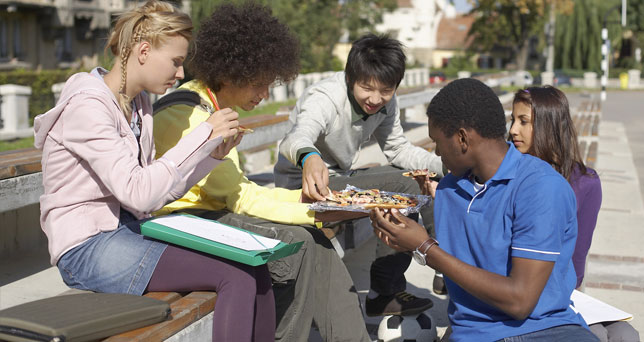
Join Nationwide Movement: Promote Acceptance & Inclusion
Lunchtime is the primary social period during the school day. Many students look forward to lunchtime as an enjoyable time with friends and a much-needed break from studies, but students who feel like they are on the fringes often look upon this agonizing hour with dread.
National No One Eats Alone Day is a student-led movement that aims to reduce social isolation by promoting kindness, acceptance and inclusion. Students can seek and find classmates in need of a friend, yet many students feel uncomfortable with introducing themselves to someone that they have never met before. Therefore, lunchtime events and activities are helpful icebreakers that encourage positive interaction on campus so that all students feel welcomed and included. No One Eats Alone Day aims to create a sense of belonging and connectedness among students on campus; a spark that inspires students to accept others in light of their differences.
Here are some ways that you can help to reduce social isolation and make a positive impact on your school climate for No One Eats Alone Day and every day:
- Invite a lonely student to sit with you at lunch.
- With administrator approval, conduct an anonymous poll (like this one here) that collects students’ perceptions of school climate on your campus. Use the data in your No One Eats Alone Day projects, campaigns and initiatives.
- Host a lunchtime event with activities that promote positive social interaction.
- Start a school club to welcome new students or to give all students a welcoming place to spend lunch time. Like this student here.
- Design informational flyers and posters that educate and inform your student body on the problem and effects of social isolation.
- Produce a 30-60 second video Public Service Announcement (PSA)* that encourages your fellow students to reduce social isolation and create a culture of acceptance and inclusion. Coordinate with the appropriate school staff members and broadcast the video on the school network, website, or school-based social media channels.
- Create a 3-5 minute Short Form Documentary* on social isolation and the positive impact that this initiative has made on your school campus. Demonstrate how kindness, acceptance and inclusion reduces social isolation. Your video may include true stories from students, perspectives from teachers and administrators, and expert interviews. Coordinate with the appropriate school staff members and broadcast the video on the school network, website, or school-based social media channels.
- Ask your high school Student Council or Associated Student Body (ASB) to promote this initiative through assemblies, posters, lunchtime activities and even a social media campaign!
- iDrive reaches millions of students nationwide. Inspire students all across the country to reduce social isolation and promote acceptance and inclusion in their own schools by submitting your projects to the iDrive Student Advisory Board below.
*Important: Make sure that everyone has given you a signed Personal Release Form. Always get permission from parents/guardians before you record those under age 18.
Go Social! Check out what schools across the nation are sharing on social media with these hashtags: #NoOneEatsAlone #NoOneEatsAloneDay #NOEA2018
Need some inspiration? Watch the National No One Eats Alone Day video produced by our iDrive Student Advisory Board video production team.
iDrive wants to hear from you!
Want to start your own iDrive campaign or have a topic that you want iDrive to address? Send us a direct message on social media or send an e-mail at advisoryboard@isafeventures.org
Want to contribute social media content to future iDrive campaigns? Submit your application to join the iDrive Student Advisory Board here.
Are you reading this article, but you’re not yet an iDrive Agent? Sign up here.
Follow iDrive on Facebook, Twitter and Instagram.
Related Stories:
- National No One Eats Alone Day
- Social Isolation: An Underlying Issue
- Social Isolation: Effects on Youth
References:
Benner, A.D. (2011). Latino Adolescents’ Loneliness, Academic Performance, and the Buffering Nature of Friendships, Journal of Youth and Adolescence, 40 (5): 556-567 DOI: 10.1007/s10964-010-9561-2
Centers for Disease Control and Prevention (2015). Retrieved from http://www.cdc.gov/
Eder, A. (1990). Risk Factor Loneliness. On the Interrelations between Social Integration, Happiness, and Health in 11-, 13-, and 15-year old Schoolchildren in 9 European Countries, Health Promotion International, 5: 19-33. 38. DOI: https://doi.org/10.1093/heapro/5.1.19
Eva H. Telzer, Andrew J. Fuligni, Matthew D. Lieberman, Michelle E. Miernicki, Adriana Galván; The quality of adolescents’ peer relationships modulates neural sensitivity to risk taking, Social Cognitive and Affective Neuroscience, Volume 10, Issue 3, 1 March 2015, Pages 389–398, DOI: https://doi.org/10.1093/scan/nsu064
Fontaine, R.G., Yang, C., Burks, B.S., Dodge, K.A. Price, J.M., Pettit, G.S. & Bates, J.E. (2009). Loneliness as Partial Mediator of the Relation between Low Social Preference in Childhood and Anxious/Depressed Symptoms in Adolescence, Development and Psychopathology, 21: 479-491. DOI: 10.1017/S0954579409000261
Goosby, B. J., Bellatorre, A., Walsemann, K. M., & Cheadle, J. E. (2013). Adolescent loneliness and health in early adulthood. Sociological Inquiry, 83(4), 505-536. DOI: 10.1111/soin.12018
Hall-Lande J, Eisenberg M, Christenson S, Neumark-Sztainer D. (2007). Social Isolation, Psychological Health, and Protective Factors in Adolescence. Adolescence, 42 (166): 265-286. https://www.ncbi.nlm.nih.gov/pubmed/17849936
Harris, R.A., Qualter, P., & Robinson, S.J. (2013). Loneliness Trajectories from Middle Childhood to Early Adolescence: Impact on Perceived Health and Sleep Disturbances, Journal of Adolescence, 36: 1295-1304. http://isiarticles.com/bundles/Article/pre/pdf/60551.pdf
Ladd, G. & Ettekal, I. (2013). Peer-related Loneliness across Early to Late Adolescence: Normative Trends, Intra-Individual Trajectories, and Links with Depressive Symptoms, Journal of Adolescence, 36: 1269-1282. DOI: 10.1016/j.adolescence.2013.05.004
Lohre, A. (2012). The Impact of Loneliness on Self-Rated Health Symptoms among Victimized School Children, Child and Adolescent Psychiatry and Mental Health, 6, 20. DOI: https://doi.org/10.1186/1753-2000-6-20
Mahon, N.E. (1994). Loneliness and Sleep during Adolescence, Perceptual & Motor Skills, 78: 227–231. http://journals.sagepub.com/doi/abs/10.2466/pms.1994.78.1.227
Qualter, P., Brown, S.L., Munn, P., Rotenberg, K.J. (2010). Childhood Loneliness as a Predictor of Adolescent Depressive Symptoms: an 8-year Longitudinal Study, European Child and Adolescent Psychiatry, 19: 493-501. DOI: 10.1007/s00787-009-0059-y
Qualter, P., Brown, S.L., Rotenberg, K.J., Vanhalst, J., Harris, R.A., Goossens, L., Bangee, M. & Munn, P. (2013). Trajectories of Loneliness during Childhood and Adolescence: Predictors and Health Outcomes, Journal of Adolescence, 36: 1283-1293. DOI: https://doi.org/10.1016/j.adolescence.2013.01.005
Schinka, K., VanDulmen, M., Bossarte, R., Swahn, M. (2012). Association between Loneliness and Suicidality during Middle Childhood and Adolescence: Longitudinal Effects and the Role of Demographic Characteristics. The Journal of Psychology: Interdisciplinary and Applied, 146 (1-2): 105-118. DOI: https://doi.org/10.1080/00223980.2011.584084
Shochet, I.M., Dadds, M.R., Ham, D., & Montague, R. (2006). School Connectedness is an Underemphasized Parameter in Adolescent Mental Health: Results of a Community Prediction Study, Journal of Clinical Child and Adolescent Psychology, 35 (2): 170-179. DOI: https://doi.org/10.1207/s15374424jccp3502_1
Vanhalst, J., Goossens, L., Luyckx, K. Scholte, R.H.J., & Engels, R.C.M.E. (2013). The Development of Loneliness from Mid- to Late Adolescence: Trajectory Classes, Personality Traits, and Psychosocial Functioning, Journal of Adolescence, 36: 1305-1312. DOI: 10.1016/j.adolescence.2012.04.002














